
The Combretaceae, often called the white mangrove family, are a family of flowering plants in the order Myrtales. The family includes about 530 species of trees, shrubs, and lianas in ca 10 genera. The family includes the leadwood tree, Combretum imberbe. Three genera, Conocarpus, Laguncularia, and Lumnitzera, grow in mangrove habitats (mangals). The Combretaceae are widespread in the subtropics and tropics. Some members of this family produce useful construction timber, such as idigbo from Terminalia ivorensis. The commonly cultivated Quisqualis indica is now placed in the genus Combretum. Many plants in the former Quisqualis genus contain the excitotoxin quisqualic acid, a potent AMPA agonist.
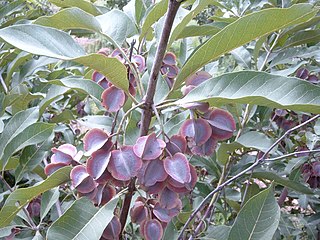
Combretum, the bushwillows or combretums, make up the type genus of the family Combretaceae. The genus comprises about 272 species of trees and shrubs, most of which are native to tropical and southern Africa, about 5 to Madagascar, but there are others that are native to tropical Asia, New Guinea and the Bismarck Archipelago, Australia, and tropical America. Though somewhat reminiscent of willows (Salix) in their habitus, they are not particularly close relatives of these.
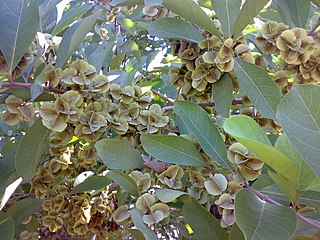
Combretum quadrangulare, or commonly known as sakae naa, is a small tree of the family Combretaceae, up to 10 m high. The tree grows wildly or is planted in Vietnam, Cambodia, Laos, Myanmar and Thailand.

Combretum indicum, also known as the Rangoon creeper, is a vine with red flower clusters which is native to tropical Asia.
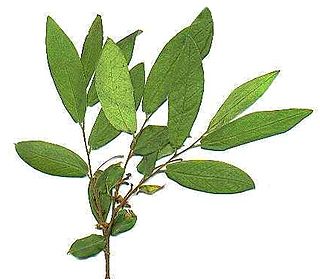
Combretum edwardsii, the Natal combretum or forest climbing bushwillow, is an uncommon forest plant endemic to the mistbelt region of eastern South Africa. It has a climbing habit and the stems may often lie prostrate on the forest floor or on cliff tops. As with some other Combretum species the leaves assume autumn colours before they are shed. The plant flowers in spring and the 4-winged fruits reach maturity in late summer.

Combretum padoides, the thicket bushwillow, occurs in the lowlands of tropical and south-eastern Africa. They grow in a range of habitats from muddy riverbanks to dry rocky hillsides. The mostly opposite oval leaves are carried on long slender branches. The trees or shrubs flower in profusion in mid-summer and the 4-winged fruits reach maturity from late summer to mid winter.

Wildlife of the Gambia is dictated by several habitat zones over its total land area of about 10,000 km2. It is bound in the south by the savanna and on the north by the Sudanian woodlands. The habitats host abundant indigenous plants and animals, in addition to migrant species and newly planted species. They vary widely and consist of the marine system, coastal zone, estuary with mangrove vegetation coupled with Banto Faros, river banks with brackish and fresh water zones, swamps covered with forests and many wetlands.

The white-bellied sunbird, also known as the white-breasted sunbird, is a species of bird in the family Nectariniidae. It is found in Angola, Botswana, Democratic Republic of the Congo, Eswatini, Malawi, Mozambique, Namibia, South Africa, Tanzania, Zambia, and Zimbabwe.
Heptapleurum multinervium is a species of plant in the family Araliaceae. It is endemic to Yunnan Province of China.

Combretum glutinosum is a shrub species of the genus Combretum, found in the Sahel belt in parts of Senegal, Burkina Faso, Ghana, Mali, the Gambia, Niger, Nigeria and Cameroon, across to parts of Sudan. It is known as dooki in Pulaar, Kantakara in Hausa, rat in Wolof and jambakatan kè in Maninka. Its synonyms are Combretum cordofanum Engl. & Diels, C. passargei Engl. & Diels, C. leonense Engl. & Diels.

Combretum erythrophyllum, commonly known as the river bushwillow, is a medium to large-sized, spreading tree found in bush along river banks in southern Africa. It is planted as a shade and ornamental tree in South Africa and the United States, and is propagated by seed.

Combretum molle, the velvet bushwillow, is a medium to large tree species in the genus Combretum found in western, eastern and southern Africa.

Combretum paniculatum, the burning bush or forest flame-creeper, is a plant species in the genus Combretum found in Africa. The fruit is a samara, i.e. a winged seed.
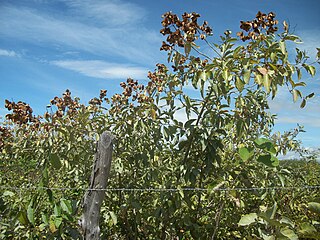
Combretum leprosum, the mofumbo in Portuguese and the asucaró in eastern Bolivian Spanish, is a plant species in the genus Combretum found throughout the Amazon Basin.

Combretum hereroense, commonly known as the russet bushwillow and the mouse-eared combretum, is a deciduous shrub or small tree that is found from eastern Africa to northern South Africa. Over its extensive range it is variable with respect to leaf shape, fruit size and indumentum.
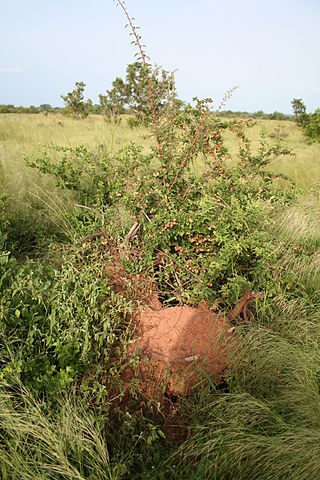
Combretum aculeatum is a species of flowering plant in the bushwillow genus Combretum, family Combretaceae. It is native to the Sahelian and Sudanian savannas and adjacent forest–savanna mosaic in Africa and Saudi Arabia, and has been introduced to Myanmar. High in protein, it is greatly relished as a browse by wild and domesticated mammalian herbivores, except elephants.
Strephonema pseudocola is a species of flowering plant in the family Combretaceae. It is a tree found in the forests of tropical West Africa. It was first described from the Ivory Coast.

Combretum zeyheri, the large-fruited bushwillow or Zeyher's bushwillow, is a species of flowering plant in the family Combretaceae, usually found growing on acidic or sandy soils in tropical African savannas. A small to medium-sized tree, its roots are used as a source of material for making baskets and as a traditional medicine for haemorrhoids.
Combretum celastroides is a species of flowering plant in the bushwillow genus Combretum, family Combretaceae. It is found in Zambia, Zimbabwe, Botswana, and Namibia, and is also known in English as Jesse-bush bushwillow, Trailing bushwillow, or Zambezi jessebush, and in local languages as Mugalusaka and Umlalanyathi.















